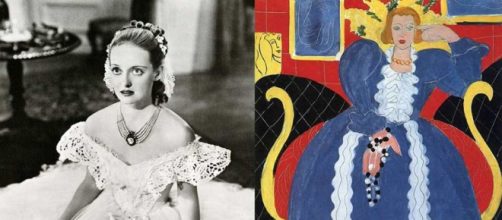Boca Raton Museum’s promising show titled “Art Meets Hollywood” is not a meet so much as a passing glance.
The focus is on appearance in both movie stills and paintings dated the same year. Linking by year doesn’t add anything to what you see.
Seeing things that aren’t there
This is not to say that “Art Meets Hollywood” isn’t entertaining. But when the artist, Bonnie Lautenberg, collages movie stills with paintings, the paintings lose their meaning. .
Look at the film clip of Betty Davis as the evil-doing southern belle in the 1938 flick “Jezebel” paired with Matisse’s painting “Woman in Blue.” As the painting’s owner Philadelphia Museum of Art points out on its website, Matisse paid attention to the costume rather than the personality of the sitter – (Lydia Delectorskaya - his model for 20 years).
Is Lautenberg suggesting a moral equivalent between Jezebel and Lydia?
Another pairing that raises questions is Rene Magritte’s painting “The Lovers” and a 1928 movie-still from “The Mysterious Lady” showing a cinematic cliché - a kiss.
Magritte’s painting cloaks the cliché in a winding sheet, like graveclothes. By itself, it is unsettling to see. But paired with the film clip, it comes off as a joke.
The owner of the painting, the Museum of Modern Art, says on its website that by covering up the cliché, Magritte is asking viewers to think beyond the merely visible. But this is not what Laufenberg asks her audience to do.
Then there are visual connections that look forced. Georgia O’Keeffe’s painting “Jimson Weed/White Flower No.
1” collaged with a scene from the 1932 film “Grand Hotel” of a reclining female outfitted in fluffy white.
While “The Grand Hotel” is heavy with intrigue and secrets, ‘Jimson Weed/White Flower” was O’Keeffe’s avowed way of showing what she called “the wideness and wonder of the world as I live in it.” Where’s the connection?
“You’re going to need a bigger boat”
Perhaps the most successful pairing is a movie-still of the 1975 movie “Jaws” with Willem De Kooning, “Untitled “V 55.”
Though completely abstract, De Kooning’s unrestrained rash of smears and drips streaked in red captures the frenzied thrashing of swimmers attempting to escape from the jaws of hungry sharks.
There are also pairings that are hard to figure out. Consider a scene from the 1994 movie “Pulp Fiction” pictured with Kenny Scharf’s biomorphic abstraction “Globe Glob,” that he said was inspired by the BP oil spill.
Is Lautenberg suggesting that the movie tale of violence and redemption is comparable to the deep-water drilling accident? Given that she deals with appearance only, any thought of environmental hazards seems out of the question.
Clearly, focusing on the way things look doesn’t take you very far. The very least that Lautenberg could have done is collage film and fine art that is superficially compatible.
Instead, you get couplings like Katherine Hepburn lighting Jimmy Stewart’s cigarette in the 1940 movie “The Philadelphia Story” with Stuart Davis’ abstraction “Hot Still-Scape for Six Colors – 7th Avenue Style.”
According to the Museum of Fine Arts in Boston where the painting is held, “Hot” in the artist’s view describes a lively Manhattan street.
Perhaps it can be argued that the Hepburn-Stewart relationship was dynamic, too. But audiences would have to know about both painting and the motion picture, wouldn’t they?
All the while I’m crabbing about this show, you should know that Levi Prombaum, curatorial assistant at the Guggenheim Museum praises Lautenberg for making paintings “disrupt the way you think about the paintings and film.”
I'm all for disruption in art. Corrupting it is another matter.


